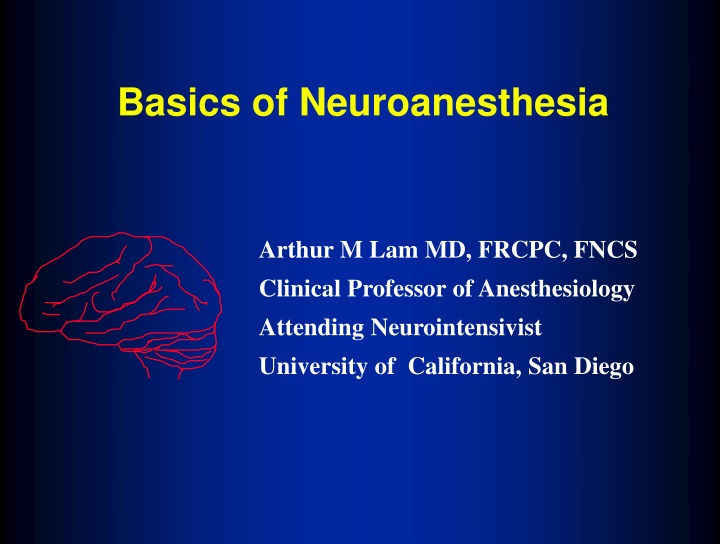Basics of Neuroanesthesia
The intricate mechanisms involved in regulating cerebral blood flow during neuroanesthesia, including factors like pressure autoregulation, metabolic control, and the influence of inhaled agents. Discover the critical interplay between flow and metabolism coupling in maintaining optimal brain perfusion.
Download Presentation

Please find below an Image/Link to download the presentation.
The content on the website is provided AS IS for your information and personal use only. It may not be sold, licensed, or shared on other websites without obtaining consent from the author.If you encounter any issues during the download, it is possible that the publisher has removed the file from their server.
You are allowed to download the files provided on this website for personal or commercial use, subject to the condition that they are used lawfully. All files are the property of their respective owners.
The content on the website is provided AS IS for your information and personal use only. It may not be sold, licensed, or shared on other websites without obtaining consent from the author.
E N D
Presentation Transcript
Basics of Neuroanesthesia Arthur M Lam MD, FRCPC, FNCS Clinical Professor of Anesthesiology Attending Neurointensivist University of California, San Diego
CBF = 50 ml/100 gm/min CMRO2 = 3.2 ml/ 100 gm/ min AVDO2 = 6.4 vol % SjvO2 = 65 70%
Regulation of Cerebral Blood Flow Flow-Metabolism Coupling Pressure Autoregulation metabolic (adenosine?) myogenic Chemical Control CO2/O2 Neurogenic?
CBF during different stages of sleep From Madsen and Vorstrup Cerebrovas Brain Metab Review 1991
Cerebral Autoregulation CBF 60 160 Blood Pressure (mmHg)
Inhaled Agents and CBF Influence of flow-metabolism coupling
Isoflurane Maekawa et al Anesthesiology 1986
Change in Flow Velocity with EEG activity during High Dose Isoflurane Anesthesia
ISOFLURANE 80 Pt #1 Pt #2 Pt #3 60 Pt #4 40 FLOW VELOCITY (cm/s) 20 0 ACTIVITY SUPPRESSION EEG
Halothane CBF Isoflurane Sevoflurane 1 2 3 MAC
Conclusions: Both anesthetic agents caused a global reduction of rCBF (propofol > sevoflurane) at the 1 MAC/EC50 level. The effect was maintained at higher propofol concentrations, whereas 2 MAC sevoflurane caused noticeable flow redistribution. Kaisti et al Anesthesiology 2002
Effects of Nitrous Oxide on Global and Regional Cortical Blood Flow Deutsch and Samra Stroke 1990 Percentage of baseline CBF 150 100 100%O2 25%N2O 75%N2 O 21%O2
INHALATION ANESTHETICS Dual Action Hypothesis Direct: Vasodilation Indirect: flow-metabolism coupled vasoconstriction halothane isoflurane desflurane /sevoflurane Nitrous oxide
INTRAVENOUS ANESTHETICS flow-metabolism coupling thiopental etomidate propofol ketamine*
Influence of Inhalation Agents on Autoregulation High dose Moderate dose Low dose CBF Normal Blood Pressure
Autoregulation during sevoflurane anesthesia 100 100 80 80 60 60 Vmca (cm/s) (cm/s) Vmca 40 40 20 20 0 0 87 80 110 111 MAP (mmHg) MAP (mmHg) From Cho et al Anesthesiology 1996
CO2reactivity is preserved during both inhalation and intravenous anesthesia
Influence of Graded Hypercapnia on Cerebral Autoregulation during Propofol and Sevoflurane Anesthesia Hypothesis: Anesthetics may influence the interaction between PaCO2 and autoregulation Methods: 8 ASA-I Patients scheduled for lower extremity orthopedic surgery for >6 hours Randomized, cross-over design Sevoflurane 1.1% end-tidal or propofol 100 g/kg/min+ remifentanil infusion Autoregulation assessed at increasing levels of PaCO2 of 40, 50, 55, 60, 65 mmHg using TCD
Cerebral Perfusion Pressure (CPP) CPP = MAP ICP or = MAP - CVP
Treatment of h ICP Brain mannitol, lasix, lobectomy, hypertonic saline ventriculostomy drainage Blood hypervent. (temp.), head elevation, barbiturates Mass surgical evacuation CSF Hypothermia Decompressive Craniectomy
Fluid Management Crystalloid Vs Colloid ?
Crystalloids vs Colloids Osmotic press. more important than oncotic press With significant disruption of BBB, osmotic press. may be important Hypertonic saline may be useful Colloid use remains controversial
Osmolarities of common IV solutions Solution 0.9% n saline Lactated Ringers Plasma-lyte 20% mannitol 3% saline 5% albumin 6% hetastarch Osmolarity 308 273 294 1098 1025 295 310
The value of experience is not in seeing much, but in seeing wisely Sir William Osler























